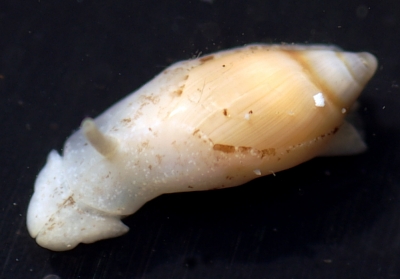
Olividae
Class: Gastropoda
Superfamily: MURICOIDEA
Family: Olividae
DISTRIBUTION
Tropical and southern temperate regions. Usually from shallow waters but alos known from deep waters.
PHOTO
Locality: La Passe, Silhouette, intertidal, Seychelles, Indian, August 2007, on interidal boulder. Length: c. 1cm. Photographer: Richard Barnes
This group of carnivorous marine snails are characterised by a genus named Oliva, although any resemblance to an olive escapes me. They range in size from about 1 cm to 10 cm. Their shells are solid and cylindrical with a distinct pointed spire and they are usually smooth and shiny. Most species are inhabitants of soft substrates found ploughing through the surface layers of sandy substrates or burrowing. Their head flattened and wedge-shaped, adapted to ploughing through sandy sediments. The head tentacles are flattened and triangular. In some groups the sides of the foot are extended into parapodia which partly enclose the shell. In many ways these adaptations resemble those found in some cephalspidean opisthobranchs such as Pupa and Acteon which live in similar habitats.
The genera include Oliva, Ancilla, and Olivella
Authorship detailsRudman, W.B., 2007 (November 2) Olividae. [In] Sea Slug Forum. Australian Museum, Sydney. Available from http://www.seaslugforum.net/find/olividae
Related messages
Cephalaspidean? from the Seychelles
November 2, 2007
From: R S K Barnes

If anyone knows to which species this small cephalaspidean belongs, would they please be so kind as to tell it to me.
Locality: La Passe, Silhouette, intertidal, Seychelles, Indian, August 2007, on interidal boulder. Length: c. 1cm. Photographer: Richard Barnes.
Many thanks!
Richard Barnes
rsb1001@cam.ac.uk
Barnes, R.S.K., 2007 (Nov 2) Cephalaspidean? from the Seychelles. [Message in] Sea Slug Forum. Australian Museum, Sydney. Available from http://www.seaslugforum.net/find/21060
Dear Richard,
This does look remarkably like some sand-dwelling cephalaspideans such as Acteon and Pupa but the development of the head into a plough to push their way through the sediment and the sides of the foot into flaps to partially enclose the shel, are both convergent adaptations for living in sandy sediments. This is a species of the Olividae, a family of carnivorous snails. Some species are found in large populations on shallow intertidal shores. They live in tropical waters and southern temperate waters but are absent from northern temperate waters. One clue to its 'snail' rather than 'slug' identity is the single median siphon we can see sticking up behind the shell which sucks water into the mantle cavity. It looks like a species of Ancilla to me but I am no expert on the group.
Best wishes,
Bill Rudman
